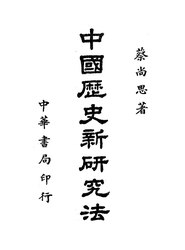File:NLC416-07jh009739-4127 中國歷史新研究法.pdf

Original file (806 × 1,089 pixels, file size: 5.77 MB, MIME type: application/pdf, 174 pages)
Captions
Captions
Summary[edit]
| 中國歷史新研究法
( |
||||||||||||||||||||||||
|---|---|---|---|---|---|---|---|---|---|---|---|---|---|---|---|---|---|---|---|---|---|---|---|---|
| Author |
蔡尚思著 |
|||||||||||||||||||||||
| Title |
中國歷史新研究法 |
|||||||||||||||||||||||
| Publisher |
中華書局發行所[發行] (昆明) |
|||||||||||||||||||||||
| Description |
從作者所著《中國思想研究法》一書中抽出與歷史有關章節,編為此書。作者試圖用馬克思主義的歷史觀研究歷史。全書分12章:歷史的關係一切、史實的成份與中國歷史的特色、中國史書的分類、科學的新史觀、歸納比較兩種鑑別方法、作史的條件、讀史的要訣、歷史的創造等。每章後均有附錄一篇。書尾有附錄3篇:《顧頡剛先生來書及中國思想研究法序》、《中國歷史用書選要》、《對於中國通史與歷史學系科目表草案之意見(上教育部書)》
目錄 |
|||||||||||||||||||||||
| Language | Chinese | |||||||||||||||||||||||
| Publication date | 民國29[1940] | |||||||||||||||||||||||
| Source |
institution QS:P195,Q732353
(民國時期文獻 民國圖書) |
|||||||||||||||||||||||
| 主題 InfoField | 歷史-中國 | |||||||||||||||||||||||
| 中圖分類 InfoField | K207 | |||||||||||||||||||||||
| 拼音題名 InfoField | zhong guo li shi xin yan jiu fa | |||||||||||||||||||||||
| 載體形態 InfoField | 158頁 | |||||||||||||||||||||||
Licensing[edit]
This image is in the public domain because it is a mere mechanical scan or photocopy of a public domain original, or – from the available evidence – is so similar to such a scan or photocopy that no copyright protection can be expected to arise. The original itself is in the public domain for the following reason:
This tag is designed for use where there may be a need to assert that any enhancements (eg brightness, contrast, colour-matching, sharpening) are in themselves insufficiently creative to generate a new copyright. It can be used where it is unknown whether any enhancements have been made, as well as when the enhancements are clear but insufficient. For known raw unenhanced scans you can use an appropriate {{PD-old}} tag instead. For usage, see Commons:When to use the PD-scan tag. |
| This image contains digital watermarking or credits in the image itself. The usage of visible watermarks is discouraged. If a non-watermarked version of the image is available, please upload it under the same file name and then remove this template. Ensure that removed information is present in the image description page and replace this template with {{Metadata from image}} or {{Attribution metadata from licensed image}}.
Caution: Before removing a watermark from a copyrighted image, please read the WMF's analysis of the legal ramifications of doing so, as well as Commons' proposed policy regarding watermarks. If the old version is still useful, for example if removing the watermark damages the image significantly, upload the new version under a different title so that both can be used. After uploading the non-watermarked version, replace this template with{{Superseded|new filename|version without watermarks}}.Bahasa Indonesia ∙ italiano ∙ eesti ∙ sicilianu ∙ Deutsch ∙ català ∙ magyar ∙ čeština ∙ română ∙ español ∙ português ∙ English ∙ hrvatski ∙ Plattdüütsch ∙ français ∙ Nederlands ∙ polski ∙ galego ∙ slovenščina ∙ suomi ∙ svenska ∙ Ελληνικά ∙ беларуская (тарашкевіца) ∙ български ∙ македонски ∙ русский ∙ українська ∙ മലയാളം ∙ ไทย ∙ 日本語 ∙ 中文 ∙ 中文(简体) ∙ 中文(繁體) ∙ עברית ∙ العربية ∙ فارسی ∙ +/− |
File history
Click on a date/time to view the file as it appeared at that time.
| Date/Time | Thumbnail | Dimensions | User | Comment | |
|---|---|---|---|---|---|
| current | 08:55, 10 June 2023 |  | 806 × 1,089, 174 pages (5.77 MB) | PencakeBot (talk | contribs) | Upload 中國歷史新研究法 (1/1) by 蔡尚思著 (batch task; nlc:data_416,07jh009739,4127; 民國圖書.3; 中國歷史新研究法) |
You cannot overwrite this file.
File usage on Commons
The following page uses this file:
Metadata
This file contains additional information such as Exif metadata which may have been added by the digital camera, scanner, or software program used to create or digitize it. If the file has been modified from its original state, some details such as the timestamp may not fully reflect those of the original file. The timestamp is only as accurate as the clock in the camera, and it may be completely wrong.
| Conversion program | Foxit GSDK - Foxit Software Inc. |
|---|---|
| Encrypted | no |
| Page size |
|
| Version of PDF format | 1.7 |






